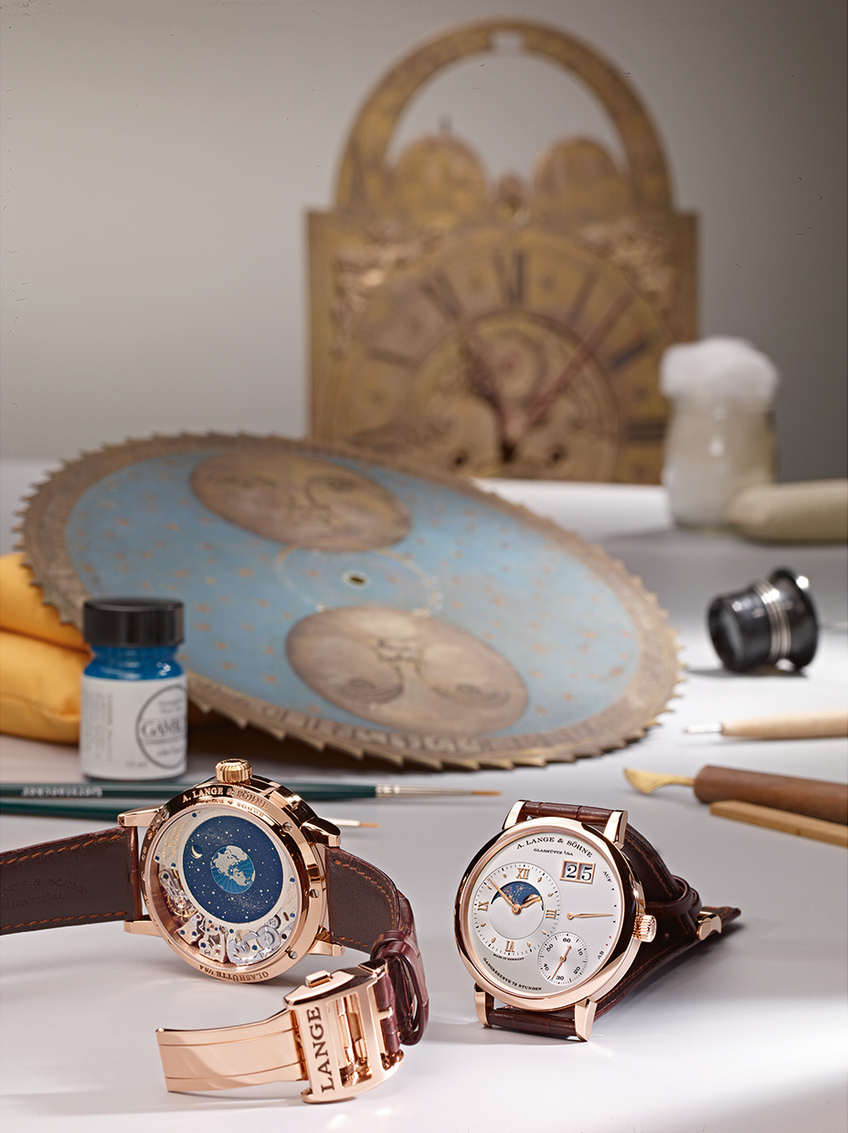The moon in Saxony’s sciences – Part 2
The moon in Saxony’s sciences – Part 2
Moon-phase watches by A. Lange & Söhne and impressive witnesses of lunar research in Saxony
The moon, as one of the most prominent celestial bodies, has been preoccupying humankind for millennia. In Saxony, too, the earth’s satellite, its orbital progression and its influence on various spheres of life intrigued citizens, scholars and regents alike. This interest spawned countless drawings, reports and novels that even today reflect the enthusiasm of their authors for the moon.
In the early days of lunar observations, people were interested mainly in its progression across the nocturnal skies and its changing faces. The focus among researchers shifted to its surface after the telescope was invented in the unfolding 17th century. Old lunar maps and moon globes reproduce what scholars and enthusiasts were able to see and emulate with the resources of their epoch. Painstaking observations and highly detailed drawings testify to the passion and perseverance of their originators. The famous lunar map by the Dresden astronomer Wilhelm Gotthelf Lohrmann (1796–1840) is an example from the 19th century, but the moon has lost none of its fascination to this very day. In the 1960s, Dresden native Ursula Seliger created an extensive series of detail-rich pencil drawings which she compiled in three volumes.
Today, these drawings are stored at the Palitzsch Museum in Dresden, which was reopened in early May 2014 after extensive renovations. The facility was named after Johann George Palitzsch (1723–1788), a so-called “peasant astronomer” who, apart from working on his farm, also devoted his time to astronomy. He became famous for rediscovering Halley’s Comet. His interest in celestial phenomena was so great that in the evening of Christmas Day, 25 December 1758, he pointed his telescope toward the skies in search of the comet’s tail. For months, astronomers all over the world had been awaiting its arrival, which had been predicted by Edmond Halley (1656–1742) as early as 1705. Halley reckoned that the comet, last seen in 1682, was periodic and would show up again in about 76 years. So its discovery by Palitzsch was no mere fluke. It resulted from years of diligent study in, among other places, the archives of the “Mathematics and Physics Cabinet”, which he visited regularly. When Palitzsch passed away in 1788, he left behind a library containing 3518 books and dozens of scientific instruments that 25 years later were lost to pillage during the Battle of Dresden. In homage to Palitzsch, the International Astronomical Union named three lunar craters after him in 1935. The mission of the small museum in Dresden, which is near to his devastated farm, is to inspire children and youngsters to discover their world by observing it closely and mainly with their own eyes, just as Palitzsch did in his day.
In 2014, A. Lange & Söhne presented three debuts that have a special affinity with the moon. The GRAND LANGE 1 MOON PHASE is the first Lange watch that focuses on the earth’s companion and positions it within the hour dial. In the LANGE 1 TOURBILLON PERPETUAL CALENDAR, the moon-phase display lies within the subsidiary seconds dial. The orbital moon-phase display in the RICHARD LANGE PERPETUAL CALENDAR “Terraluna”, which consists of three solid-gold discs, is located on the caseback side and apart from the moon phase also depicts the current constellation of the earth, the sun and the moon.

French writer Jules Verne’s book “Around the Moon” was published in 1870 and recounts the story of three men who shot themselves to the moon with a space gun. With its portrayal and highly detailed descriptions of the moon, written about 100 years before the first lunar landing, this book still fascinates many readers today.
The LANGE 1 TOURBILLON PERPETUAL CALENDAR combines two classic complications with the iconic design of A. Lange & Söhne’s most famous watch family. Thanks to the lucid arrangement of the calendar displays around the time indication, it presents a wealth of clearly legible information.

The lunar disc in the background is part of a clock built by Dutch watchmaker Vincent van Amelonsen in 1742. Currently, it is in the workshop run by Frank Dornacher, a Dresden-based watch restoration specialist. Deposits and corrosion will be removed and dis-colourations repaired.
The patented orbital moon-phase display in the RICHARD LANGE PERPETUAL CALENDAR “Terraluna” is located on the movement side of the model. Visible through a round aperture in the celestial disc, which is studded with 2116 stars, the moon orbits around the earth anti-clockwise.


